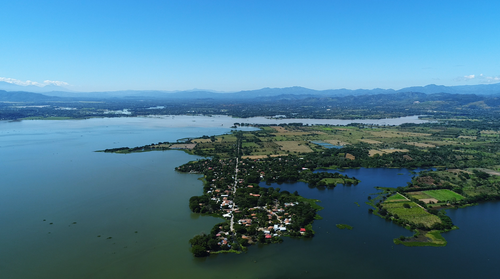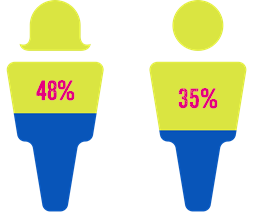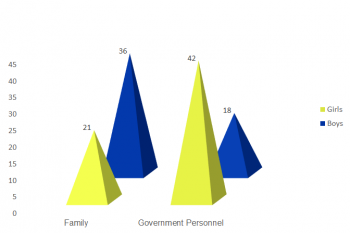Plan International (Plan) has recently completed a study on the impacts of natural hazards exacerbated by climate change in El Salvador. We focused on how differently the impacts of a changing climate are experienced by people of different ages and genders. Some of what we learned in the study is presented in this blog.

El Salvador’s vulnerability to natural hazards
El Salvador is highly vulnerable to natural hazards, including tropical storms, seasonal flooding, earthquakes, and volcanic eruptions. As much as 89% of the country is at risk of flooding or debris flows; and 95% of the population live in areas considered at high risk.
This already high level of vulnerability is increasing as extreme weather is becoming more frequent and intense as a result of climate change.
In 2020 El Salvador was hit by three hurricanes (“Amanda-Cristobal”, “Eta” and “Iota”). The flooding caused by “Amanda-Cristobal” alone affected the lives of around 150,000 people in El Salvador.
What are young people’s experience of natural hazards in El Salvador?
It is hopefully common knowledge that natural hazards affect people from different age and gender groups differently.
At Plan International we believe that children and adolescents must be part of the solution to address the impacts of climate change.
To understand how children and young people in El Salvador experience the effects of climate change exacerbated hazards like floods, and to what extent their rights are understood and upheld in relation to such events we conducted a study posing the following questions:
- How are young people’s rights, such as their social and cognitive development, education and livelihoods, impacted by natural hazards in El Salvador, and how is this different for girls, boys, and adolescents?
- What resilience actions are girls, boys, and adolescents taking to address the effects of climate change?
- What actions should be considered in public policies and regulatory frameworks at the operational, strategic, and structural levels to increase resilience and reduce violations of rights of children and adolescents in the face of increasing natural hazards as a result of climate change?
What we learned from our research
More than 80% of the girls, boys and adolescents who participated in the study said that they experienced an increase of natural hazards in their community.
Education in emergencies

Children and adolescents feel their right to education is compromised in times of emergencies. While this concerns both girls and boys, the results show that the impact is felt more strongly by girls (48%) than boys (35%). A high percentage of both girls (84%) and boys (82%) have seen their education interrupted because of natural hazards.
These results were confirmed in our Flood Resilience Measurement for Communities (FRMC) baseline study, and re-iterated in our post-flood study in two communities impacted by “Amanda-Cristobal” where more girls than boys missed at least one week of schooling due to flooding.
The FRMC studies also found that as there was no education plan for emergency situations, schools in flood-affected communities were closed for a long time.
Experience of safety
The study showed that girls tend to feel safer in the presence of public officials (e.g., teachers or members from civil protection) than in their inner family circles, whereas for boys it was the opposite.
These findings correlate with data from official police reports which have shown that most rights violations (including sexual abuse) are committed within the immediate family circle; and that this is exacerbated in a “crisis” situation.

Integrated risk management
Finally, the study revealed that the main institutions dealing with climate change and disaster risk management take different non-collaborative approaches. The regulatory frameworks, policies, and guidelines of climate change adaptation and mitigation on the one hand and risk management on the other hand are disintegrated.
This limits an integrated approach to resilience.
With regards to children and adolescents, no formal mechanism exists for them to contribute to disaster risk management. This is one reason why Plan supported students and teachers from the local schools in the communities where we work to establish school protection committees. Through these committees we ensure they have the equipment, knowledge, and capacity needed to make their schools safer and respond in case a flood or other natural hazards hit their community.
How do we solve the challenges facing young people in hazard prone communities?
The study participants recommended that the Ministry of Education develops a strategy of continued education in emergencies. For example, via home schooling or emergency school centres where students can go if their regular school buildings are flooded. This needs to take into account the access and coverage of all people.
Respondents emphasized that more needs to be done to address the impacts of climate change; that children should not have to see their education compromised in case of any natural hazard; and that they should be given the opportunity to participate in decision-making spaces within their communities.
Plan works to address the main findings from the study through its community work implemented under the framework of the Zurich Flood Resilience Alliance. We believe that children and adolescents are part of the solution to address the impacts of climate change, which the vast majority of participants are already exposed to in their community
Want to learn more?
- Read the full report in Spanish on the Latin America Flood Resilience Portal.
- Watch this short video summary of the findings.
- Watch this webinar where Plan International present the report and it’s findings.
- Find out more about the work Plan International is doing in El Salvador as part of the Zurich Flood Resilience Alliance.

Comments